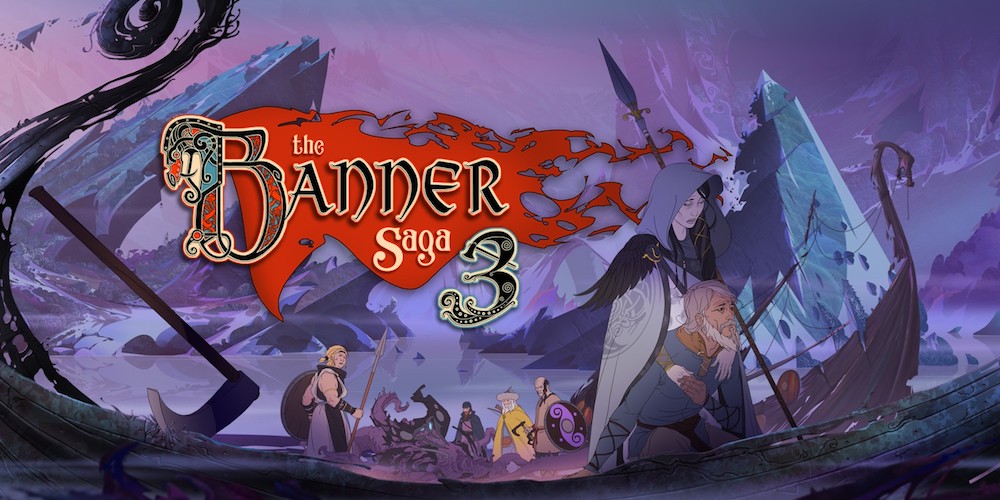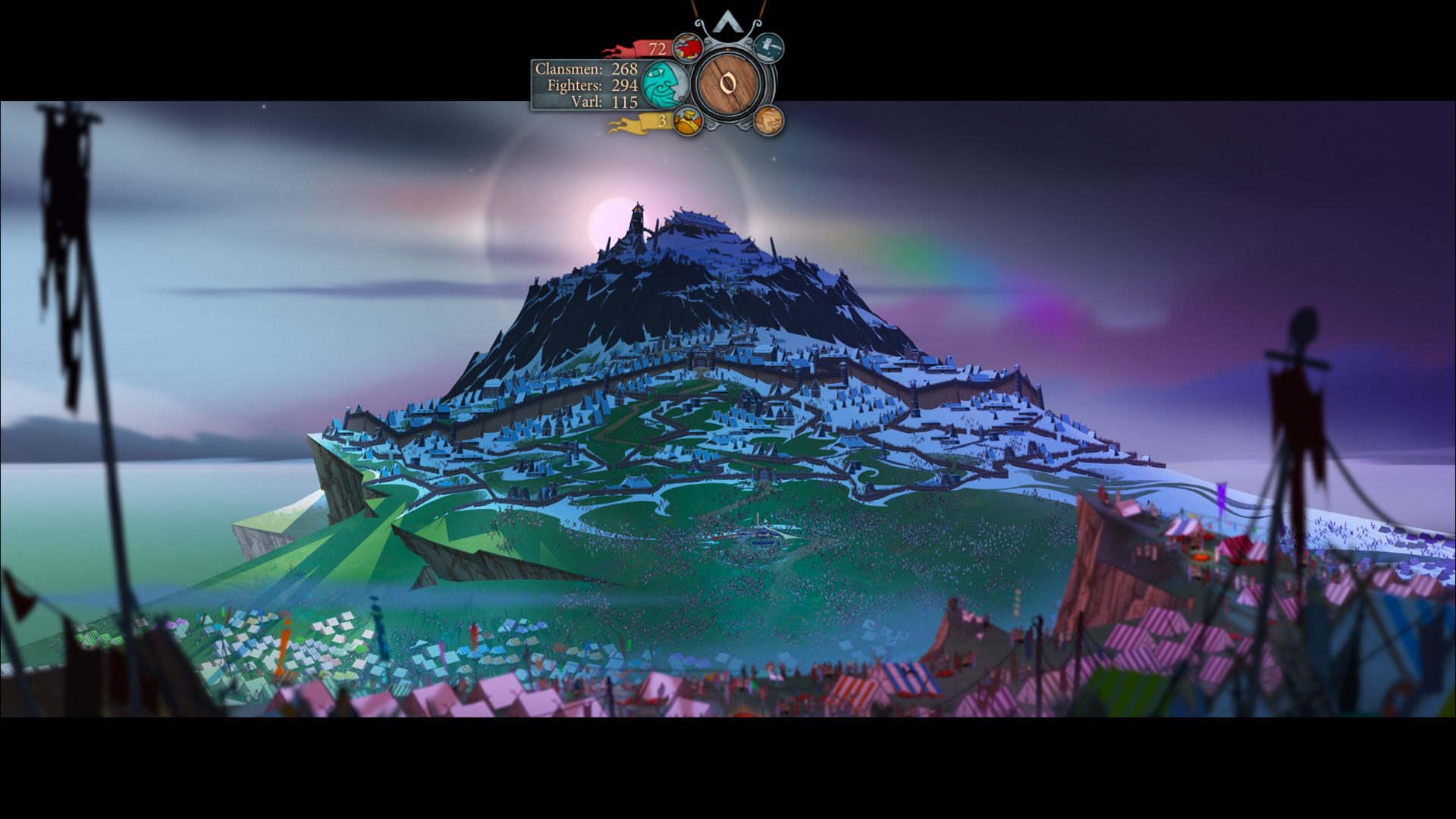
Bleak, Viking-inspired visual novel/tactical turn-based RPG hybrid series, The Banner Saga, comes to an end with this belated third instalment. Finally, the narrative closure we’ve all yearned for ever since we made the snap decision about whether Rook or Alette would fire the magical arrow at Bellower back in 2014. At last, we get to find out why the sun stopped moving and the land got covered in darkness, and just what the deal is with those darned Valka. Hooray! (If you have no idea what I’m talking about, this review is not for you. Go and start with the first game. Spoiler: If you don’t like it, you won’t like this one either).
For the most part, for better or worse, the formula is pretty much the same as in the previous two instalments. It’s still full of stunning Eyvind Earle (see also, mid-century Disney) inspired artwork. You’ll again patiently watch your caravan trudge slowly across a screen while negotiating the occasional decision-laden pop-up window. These will still be interspersed with dialogue scenes where the camera shifts from one prettily drawn still cut-out to the other as a strangely timeless way of depicting dynamic conversation in lieu of like, animation. You’ll again spend the other half the game in a turn-based combat system that can be both fun and irritating. You’ll still speculatively spend your currency on items and upgrades and supplies without really knowing what will be relevant in the near to far future. It is, basically, the same experience as before, only the final chapter as opposed to the beginning or middle. Just in case there was any doubt.

I’m happy to confirm that in the areas of art, writing and audio, Stoic have kept up the good fight here. The Banner Saga 3 is filled with compelling backgrounds. Your time is mostly split between the crowded city of Arberrang, whose chaotic business is well-illustrated here, and an eerie twilit underworld that seems suitably unpleasant, despite the pretty colours used to shade it. Both are rendered impressively. Meanwhile, the orchestral soundtrack is once again magnificent, the scoring excellent. Sombre but not overbearing, it takes a lot of the dramatic weight given the few action cutscenes and the rare incursion of a voice-acted part. The writing, too, remains strong, considered and understated. It’s a quiet marvel that Stoic has managed to sustain such a melancholy mood for three games without capitulating into self-parody or cliche. They’ve done so by writing original characters, thoughtful dialogue trees and by interspersing the ample drama with well-timed levity.
The tactical fighting system remains mostly unchanged from the previous games: it’s still an isometric, square grid, turn-based system where the player moves their six heroes around trying to kill the enemy units while minimising casualties. There are a few new enemy types and abilities to contend with in “the Twisted.” There’s also a bunch of fights which you’ll have to try and win in a limited amount of turns; otherwise, the opponent gets reinforcements, which in my experience always leads to a loss-state. While I’ve enjoyed The Banner Saga’s fighting systems for the most part, like the rest of the game, it can be frustratingly chaotic and unfair, with information obscured from the player – although at least here in part three there are fewer hidden end states unexplained mid-battle reinforcements. The system has its limitations though, and after three games worth, I can feel it wearing thin.

For a third time in this series, we find ourselves confronting the same odd question with regards to game systems and player impact and choices. Curiously, losing a battle in the Banner Saga doesn’t mean having to reload from a save and try again, as you might expect, nor does it ever seem to have any particular impact on the story. Instead, it’s a matter of numbers and resources: you get more currency to spend if you win the fight than if you lose it, although the knock-on effects here seem paper-thin. As in the two previous entries, this makes all the fighting feel strangely inconsequential to the narrative, and more and more it feels like something the player is exploring separately for their enjoyment rather than a vital part of their journey with these characters.
To an extent, it’s admirable how The Banner Saga has been willing to mess with player expectations about choice and control. The consequences of decisions are rarely telegraphed. A player might pour “Renown” (Banner Saga currency) into a hero only to have them incapacitated or killed off even before the next fight. Like few games before it, The Banner Saga gives you the impression that you are basically powerless, that you are a blind peon in a hopeless situation. Like in life, you can neither fairly expect to know the best outcome beforehand, nor do your choices ultimately matter in the big scheme of things.

On the other hand, it also just feels like strange game design. Cardinal rules continue to be broken, so what is even the point in having agency – the one things games, as opposed to other media, give us the illusion – if nothing we do seems to matter? This is carried through to the ending: there’s an implication that the sum of your choices (in terms of the number of clansmen, fighters etc. they resulted in) impact the outcome. When it came down to it for me, however, it was unclear whether they had – I ran out of bought time, and, much like all the battles I’d lost, still seemed to get some sort of victory state. But also I was beset by (what appeared to be) a glitch in this final part of the game, where one party seemed to join another for reasons unexplained (reasons that are actually inexplicable going by what had preceded it, narrative-wise). I’m not sure what happened there, but it left me feeling pretty confused.
More generally, though, endings to games with big narrative arcs are frequently disappointing – this is just a fact – but I’m reasonably happy with how The Banner Saga 3 ties together its threads (at least in the ending I got, which presumably is not the only ending). A little too much redemptive sweetness, maybe, given the apocalyptic state of things, but I found it affecting. I’m a little less enamoured with how we got there, though, particularly in the final act. I felt like things got too needlessly convoluted – I’m not entirely convinced Bolverk’s arc was at all necessary here for instance, while certain aspects of the Arberrang drama seemed a bit much – and how this ending did or didn’t arbitrarily emerge from the game systems was as much a source of frustration as it was interest.

The Banner Saga 3 is a fitting conclusion to a compelling but flawed series. It maintains and expands upon the high standards set in writing, visuals and soundtrack by the previous games. The combat is okay but still doesn’t compare too favourably to other turn-based tactical games. And the way combat outcomes still appear to have minimal effect on the story seems hard to justify. There are some interesting environmental and philosophical questions put to the player through the narrative and ludic systems, and that’s the rub of it, I think. If you’ve seen the series through this far, it’s worth seeing it out to the end, but if you already weren’t on board, this final act isn’t likely going to sway you.











